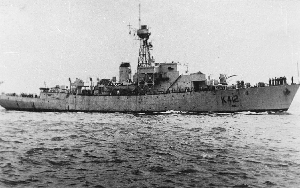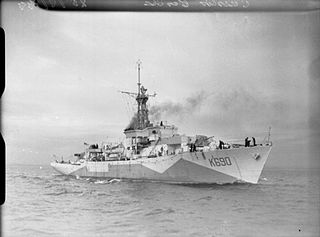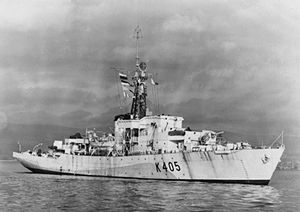Design and description
The Castle-class corvette was a stretched version of the preceding Flower class, enlarged to improve seakeeping and to accommodate modern weapons. The ships displaced 1,010 long tons (1,030 t ) at standard load and 1,510 long tons (1,530 t) at deep load. They had an overall length of 252 feet (76.8 m), a beam of 36 feet 9 inches (11.2 m) and a deep draught of 14 feet (4.3 m). They were powered by a pair of triple-expansion steam engines, each driving one propeller shaft using steam provided by two Admiralty three-drum boilers. The engines developed a total of 2,880 indicated horsepower (2,150 kW ) and gave a maximum speed of 16.5 knots (30.6 km/h; 19.0 mph). The Castles carried enough fuel oil to give them a range of 6,500 nautical miles (12,000 km; 7,500 mi) at 15 knots (28 km/h; 17 mph). The ships' complement was 99 officers and ratings. [1]
The Castle-class ships were equipped with a single QF 4-inch (102 mm) Mk XVI gun forward, but their primary weapon was their single three-barrel Squid anti-submarine mortar. This was backed up by one depth charge rail and two throwers for 15 depth charges. The ships were fitted with two twin and a pair of single mounts for 20-millimetre (0.8 in) Oerlikon light AA guns. [2] Provision was made for a further four single mounts if needed. They were equipped with Type 145Q and Type 147B ASDIC sets to detect submarines by reflections from sound waves beamed into the water. A Type 277 search radar and a HF/DF radio direction finder rounded out the Castles' sensor suite. [3]

HMS Bamborough Castle was one of 44 Castle-class corvettes built for the Royal Navy during World War II. Completed in mid-1944 she sank the U-boat U-387 on 9 December. Aside from a brief period assigned to the Fishery Protection Squadron in 1946, the rest of her career was spent as part of the fleet reserve until she was scrapped in May 1959.

HMS Denbigh Castle (K696) was one of 44 Castle-class corvettes built for the Royal Navy during World War II. The ship was completed at the end of 1944 and was assigned to the 7th Escort Group at the beginning of 1945. While escorting her first and only Arctic convoy to Russia, she claimed to have shot down a German torpedo bomber. Denbigh Castle was torpedoed in early 1945 by the German submarine U-992, with the loss of 11 men, near the Soviet coast. The ship was beached in an effort to save her, but she was pulled off by the ebbing tide and capsized. Her wreck was declared a total loss.
SS Empire Shelter was a convoy rescue ship built for the Royal Navy during World War II, originally laid down as the Castle-class corvette HMS Barnard Castle. Completed a month before the end of the war in May 1945, she made a few short voyages before she was reduced to reserve. The ship later served as a barracks ship and then as a troopship before she was sold for scrap in 1955.
HMS Allington Castle was one of 44 Castle-class corvette built for the Royal Navy during the Second World War. She was named after Allington Castle in Kent. Completed in 1944, she served as a convoy escort during the war and on fishery patrol duties in 1945–1947, being sold for scrap in 1958.

HMS Flint Castle (K383) was one of 44 Castle-class corvettes built for the Royal Navy during World War II. Completed at the end of 1943, the ship ran aground while training in January 1944. After repairs were completed the following month, she was briefly assigned to the 39th Escort Group for convoy escort duties in the Atlantic Ocean. Flint Castle was transferred to Escort Group B2 in March and screened convoys to and from Gibraltar until September. That month, she joined Escort Group B3 to escort convoys between Canada and Britain and continued to do so until the end of the war in May 1945. The ship then became an anti-submarine training ship in Rosyth and Campbeltown, Scotland, before moving to Portland at the beginning of 1947. Flint Castle remained there until she was taken out of service in March 1956 and broken up beginning in July 1958.

HMS Berkeley Castle was a Castle-class corvette of the United Kingdom's Royal Navy. Built and commissioned in 1943, she escorted convoys from 1944 to 1945. She later served as an air-sea rescue ship until being placed in reserve. Damaged beyond repair in the North Sea flood of 1953 while at a dry dock in Sheerness, she was scrapped a few years later. She was named after Berkeley Castle in Gloucestershire.

HMS Caister Castle was one of 44 Castle-class corvettes built for the Royal Navy during World War II.
HMS Carisbrooke Castle (K379) was one of 44 Castle-class corvettes built for the Royal Navy during World War II.

HMS Hurst Castle (K416) was one of 44 Castle-class corvettes built for the Royal Navy during World War II. Completed in June 1944, she began escorting convoys in August and was sunk by a German U-boat the following month.

HMS Mallow was a Flower-class corvette commissioned into the Royal Navy that served as a convoy escort during World War II; with the Royal Navy in 1940–1944, and with the Royal Yugoslav Navy-in-exile in 1944–1945. In Yugoslav service she was renamed Nada. Her main armament was a single 4-inch (102 mm) Mk IX naval gun, although a significant number of secondary and anti-aircraft guns were added towards the end of the war. During the war she escorted a total of 80 convoys whilst in British service, sinking one German U-boat, and escorted another 18 convoys whilst in Yugoslav service. After the war she served in the fledgling Yugoslav Navy as Nada then Partizanka, before being returned to the Royal Navy in 1949. Later that year she was transferred to the Egyptian Navy in which she served as El Sudan until she was decommissioned in 1975.
HMCS St. Thomas was a Castle-class corvette of the Royal Canadian Navy. She served during the Second World War in the Battle of the Atlantic, taking part in the sinking of the German U-boat U-877 in 1944. Initially ordered by the British Royal Navy as Sandgate Castle, the ship was transferred to Canada before completion. Following the war, the corvette was converted for mercantile use and renamed Camosun III, then Chilcotin and Yukon Star in 1958 before being broken up in Washington in 1974.
HMS Dumbarton Castle (K388) was one of 44 Castle-class corvettes built for the Royal Navy during World War II. She saw action in the Battle of the Atlantic during the war.

HMS Oakham Castle was a Royal Navy corvette of the Castle class. Built as a convoy escort during the Second World War, it later became a weather ship before being scrapped in 1977.

HMS Hever Castle was a Castle-class corvette constructed for the British Royal Navy in the Second World War. Transferred to the Royal Canadian Navy before completion, the ship was renamed HMCS Copper Cliff and saw service as a convoy escort for the remainder of the war. Following the war, the vessel was sold for mercantile use and renamed Ta Lung, operating under a Chinese flag. In 1949, the ship was taken over by the Communist Chinese government, rearmed and renamed Wan Lee.

HMCS Hespeler was a Castle-class corvette of the Royal Canadian Navy which served during the Second World War as a convoy escort that was originally ordered as HMS Guildford Castle for the British Royal Navy but before completion was transferred and renamed. Following the war, the ship was sold for mercantile use, renamed Chilcotin in 1946, Capri in 1958, Stella Maris in 1960, and Westar in 1965. The ship was destroyed by fire in 1966 while at Sarroch, Sardinia. The hulk was taken to La Spezia, Italy where Westar was broken up.

Empire Lifeguard (K443) was a convoy rescue ship of the Second World War. Initially built as HMS Maiden Castle - one of 44 Castle-class corvette built for the Royal Navy - she was completed in 1944 as a convoy rescue ship to pick up survivors from attacks on the convoys. Operated for the Ministry of War Transport (MoWT) she served in this role with convoys during the war. Post war she was operated as a transport in the Mediterranean. She was damaged by a terrorist attack and sunk in 1947 but repaired and ultimately sold for scrap in 1955.

HMS Shrewsbury Castle was one of 44 Castle-class corvette built for the Royal Navy during the Second World War. She was named after Shrewsbury Castle in Shrewsbury. Completed in 1944, she was loaned to the Royal Norwegian Navy as a convoy escort during the war, renamed HNoMS Tunsberg Castle and was sunk by a mine in December 1944.

HMS Morpeth Castle was one of 44 Castle-class corvette built for the Royal Navy during the Second World War. She was named after Morpeth Castle in Morpeth. Completed in 1943, she was used as a convoy escort during the war and was scrapped in August 1960.
HMS Tintagel Castle was one of 44 Castle-class corvette built for the Royal Navy during the Second World War. She was named after Tintagel Castle in Tintagel. Completed in 1943, she was used as a convoy escort during the war and was scrapped in August 1960.

HMS Asphodel was a Flower-class corvette that served in the Royal Navy and was built by George Brown and Company in 1940. She was named after Asphodel. Commissioned in 1940 and sunk by U-575 on 10 March 1944.














